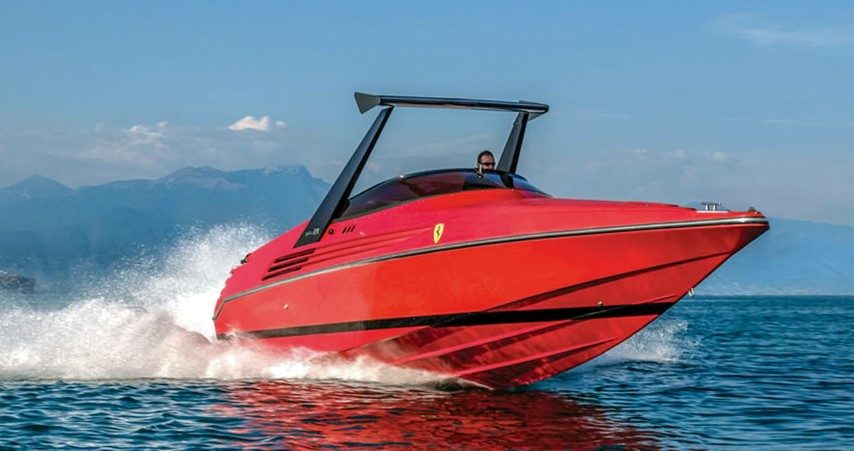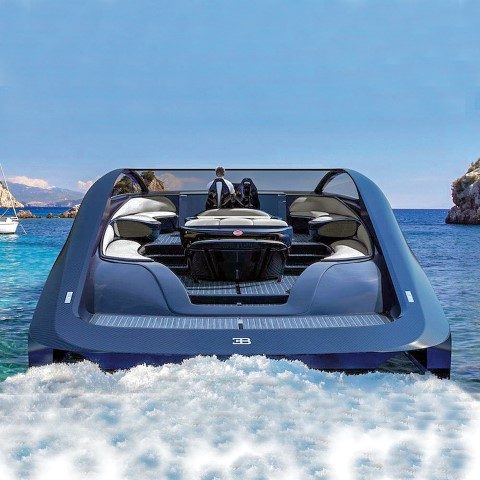

Examples of the car-to-boat design migration aren’t hard to find – even among the classic boatbuilders. In 1955 the legendary US boatyard Chris-Craft built its famous Cobra. This runabout, the water equivalent of two-seat convertible cars, followed hot on the heels of the launch of the Chevrolet Corvette, the first car featuring mass-produced fibreglass bodywork.
Then considered a futuristic (and very fashionable) material, fibreglass was adopted by Chris-Craft for the Cobra’s engine hood (a V8 of course) and for other parts of the boat.

Similarly, other car details were copied by the nautical fraternity – air intakes and dashboards, windscreens and fins – many of these originally inspired by the rockets developed in the US-USSR ‘space race’. Buick, Cadillac, Chevrolet, DeSoto, Lincoln, Plymouth, Studebaker – and even Europeans marques – adopted streamlined (aerodynamic) designs and appendices.
THE COBRA – equipped with a triangular dorsal fin and a metallic, copper-coloured paint job that disguised its artisan wood core, represented the stylistic meeting point between the traditional prewar products and the American post-war modernism.
This car-inspired design trend soon migrated to boat designers on the other side of the Atlantic. When the Riva shipyard launched the legendary Aquarama in 1962, the flavour of car-design was obvious. Says Michele Dragoni, a stylist at Milan’s famous Hot Lab studio of design: “On the old Rivas the arrangement and shape of the seats, as well as the arrangement of the dashboard and the windscreen, recalled the Chevrolet Bel Air, but also their elegant chrome details were close to those of the American convertible and cars in general.”
Car design featured prominently in the pencils of 70s and 80s designers of fast motorboats – a prime example being the legendary Cigarette. The dominant influence came from the lines of the supercars and racing prototypes, including dragsters, and was found in grilles, windshields, chrome plating and cockpits.

Why did this design migration occur? According to Francesco Paszkowski, a designer who works closely with shipyards such as Baglietto, Sanlorenzo, Custom Line and Tankoa, “cars are to be counted among the most important sources of inspiration for a boat designer because they come from a world where a lot of money is invested in research, much more than they circulate in the boating world.”
Details such as dashboards and stern shapes, says Paszkowski, were once squared but are more rounded today. “These shapes are often inspired by cars, even if it is not always easy to see the similarities because these stylistic features are interpreted in a very personal way by the designer.”
One designer who does not mind admitting having literally ‘copied’ ideas from the sport car world is Alessandro Vismara. His MAS 28 (1999) is, by his own admission “totally inspired by the Porsche Boxster, especially in the aft part.”
But many other details in his runabout have been borrowed from the automotive industry, including the Smart seats and fuel tank cap that resembles that of the Audi TT, and the steering wheel of the BMW Z3.
“In recent years,” says Vismara, “more and more customers want to see car design reproduced in boats, typically in the air intakes and in the mouldings of the hulls. It is no coincidence that brands such as Bertone, Giugiaro and Pininfarina have decided to design boats.”
The same trend is driving the styling divisions of some of the most famous car brands – Aston Martin, Bugatti, Ferrari, Jaguar, Lexus (Toyota), Mercedes-Benz, Nissan and Porsche have all produced yachts in recent years.

And the results are being rewarded. Christian Grande collected the ‘European Motor Boat of the Year’ Award (35-45 feet category) at the recent Düsseldorf Boat Show with his Cranchi T36 Crossover. He designed the Abarth and Lancia-branded inflatable boats on behalf of SACS Marine.
Of course, not everyone is enamoured with car-inspired nautical design. Some critics sniff at what they call the ‘virus’ of gigantism that’s enveloped the yachting world, where “the dominant stylistic contamination is more architectural and involves space and volumes more than specific, tiny details,” leading to outcomes that are often “clumsy and amateurish.”
Chris Bangle, Chief of Design for BMW and now a collaborator of the Sanlorenzo shipyard, has defined as “cacophonic” the prevailing style in the superyacht world, comparing some craft to “a mess that looks like six cars that have been smashed together.”
Ouch.
But whatever the sentiments, it’s hard to escape the sense that car- and boat-design will continue to be collaborative, even if the copyright boundaries are sometimes a little blurred.
CARS & THEIR NAUTICAL COUSINS
SILVER ARROWS MARINE – ARROW 460
Gorden Wagener, Chief Design Officer of Daimler AG, refers to her as the “S-Class of the Sea”. Developed by Mercedes-Benz Style jointly with the Silver Arrows Marine, the 14m Arrow 460 embodies the soul of the Stuttgart brand. From the first glance it is evident how the automotive DNA characterises the sculptural, voluptuous, concave and convex lines of this boat.

The design’s accentuated by elegant and functional details, from the handrails integrated into the roof to other technical details of the deck. Innovative features include a bow sundeck area integrated into the deck, dual consoles and side windows that are clearly of automotive design. Like the Mercedes S-Class sedan, three versions of the Arrow are available: Limousine, Granturismo and Cabrio. All are powered by twin 440hp Yanmars.
JAGUAR/ER DESIGN – SPEEDBOAT CONCEPT In 2012 Jaguar and Ivan Erdevicki’s ER Design joined forces to create a 6.10m motorboat that never entered production. This boat – as described by Ian Callum, design director for Jaguar – “followed the idea of a traditional motorboat but presents the elegant and fast lines you would expect to find in a Jaguar.”
Adds Erdevicki: “I wasn’t asked to design something that resembled a car on the water, but an object that had many things in common with the automotive world.”

From his studio in downtown Vancouver, Erdevicki is currently following another project, called Gotham. It’s completely disconnected from the Jaguar world, but not from that of cars: a 46m Icon yacht (engineered by Van Oossanen) which is openly inspired by the world of Batman and his legendary Batmobile.
QUINTESSENCE YACHTS – ASTON MARTIN AM37 This 11.10m motorboat, presented at the Monaco Yacht Show in 2016, is the result of the collaboration between the famous Gaydon brand and Quintessence Yachts, a British shipyard with headquarters in the Netherlands.
The boat’s available with three different Mercury configurations: one with twin 370hp diesels and one with twin 430hp petrol engines. The third – a super-sport version called AM37S – is powered by twin 520hp Mercury Racing petrol engines, capable of pushing this “S” version to over 50 knots.

Powerful and dynamic, this day cruiser relies extensively on wireless technology, to the point that many functions can be remotely controlled via smartphone through an app.
The AM37 presents several stylistic features of the Aston Martin automotive tradition so dear to 007 – from the hard sliding-top to the refined finishes that have always characterised the interiors of the Gaydon cars.
PALMER JOHNSON – BUGATTI NINIETTE 66 Palmer Johnson and Bugatti need no introduction – and it’s unthinkable that a collaboration of these legendary marques would be anything but spectacular. The partnership led to the 20m PJ 66 Niniette, inspired by the Bugatti Chiron (2016), a twoseater coupé designed to replace the well-known Veyron.
Constructed in carbon and composite materials, the yacht brings typical features of the Molsheim cars – notably the double colouration – and is fitted with twin 1,000hp MAN V8 engines that push her to 44 knots.

Elegance abounds below deck, where the materials include leather, marble and precious woods. On deck there is a relaxation area with sinuous lines, complete with a Jacuzzi.
MARQUIS-LARSON – LEXUS LY 650
Founded by Toyota in 1989 in response to Acura (Honda) and Infiniti (Nissan), Lexus was reorganised in 2012 to coordinate the strategies, the planning, the design and the engineering of the brand’s products worldwide.
The exploration of Lexus beyond automotive borders then reached the nautical sector. The first Lexus-branded boat, the Sport Yacht Concept (dated 2017) was a 12.8m runabout, with original and aggressive lines, driven by a five-litre V8, with a fast hull and made using much carbon-fibre reinforced-polymer.

The latest 19.66m Lexus marine product – the LY 650 – will arrive in the second half of 2019. The Marquis-Larson group of Pulaski (Wisconsin) has been selected for building, marketing and servicing the boats.




